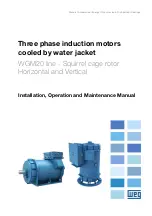
14108242 Installation, operation and maintenance manual – Squirrel cage motor – WGM20 Line l 15
3.2.2
Vertical motor handling
Vertical motors must be handled as shown in Figure 3.3;
Always use the upper lifting lugs of the motor for handling
it in the vertical position, making sure the chains and
cables are also in the vertical position, avoiding too much
stress on the lifting lugs.
Figure 3.3: Vertical motor handling
3.2.3
Vertical motor positioning
Vertical motors are supplied with lifting lugs at the drive
end DE and non-drive end NDE.
Some motors are transported in the horizontal position
and need to be moved to the original position. The
following procedure shows how to move motors from the
horizontal position to the vertical position and vice versa.
Figure 3.4: Vertical motor positioning
1.
Lift the motor with the side lifting lugs using two hoists;
2.
Lower the motor drive end (DE) and lift the non-drive
end (NDE) at the same time until balance is reached;
3.
Loosen the DE cables and turn the motor 180º in
order to enable the connection of these cables to the
other lifting lugs of the NDE;
4.
Connect the loose cables to the NDE lifting lugs and
lift them until the motor reaches the vertical position.
ATTENTION
Failure to comply with these
recommendations may cause damage to the
equipment, personal injuries or both.
3.3
STORAGE
If the Motor is not installed immediately after reception, it
must remain inside the package and stored in a location
protected against moisture, vapors, sudden changes in
temperature, rodents and insects.
The motor must be stored in vibration-free locations in
order to avoid bearing damage.
ATTENTION
Space heaters must remain powered during
storage in order to avoid moisture
condensation inside the motor.
Any damage to the paint or corrosion
protection of the machined parts must be
repaired.
3.3.1
Outdoor storage
The motor must be stored in a dry location, free of
flooding and vibrations.
Repair any damages on the package before storing the
motor, which is needed to ensure proper storage
conditions.
Place the motor on platforms or foundations that ensure
protection against humidity from the ground and prevent it
from sinking into the soil. Free air circulation underneath
the motor must be assured.
The cover used to protect the motor against the bad
weather must not be in contact with its surfaces. In order
to ensure free air circulation between the motor and such
covers, place wooden blocks as spacers.
3.3.2
Long term storage
When the motor is stored for a long period of time (two
months or more) before start-up, it is exposed to
external agents, such as temperature variations,
moisture, aggressive agents, etc.
The empty spaces inside the motor – such as rolling
bearings, terminal boxes, and windings – are exposed to
humidity, which can cause condensation, and,
depending on the degree of air contamination,
aggressive substances may also penetrate these empty
spaces.
Consequently, after long periods of storage, the winding
insulation resistance may drop below the acceptable
values, internal components, such as rolling bearings,
may oxidize, and the lubricant power of the lubricant
agent in the bearings may be adversely affected.
All of these influences increase the risk of damages
before starting the motor.
ATTENTION
To assure that the motor warranty be valid, it
is necessary to make sure that all preventive
measures described in this manual, such as
constructive aspects, maintenance,
packaging, storage, and periodical
inspections, are followed and recorded.
















































